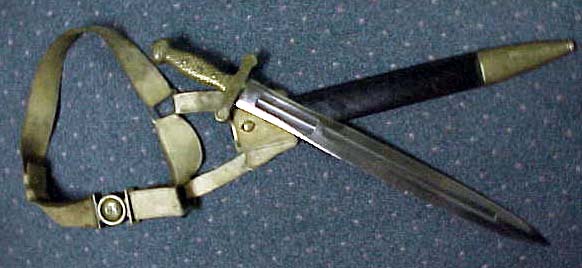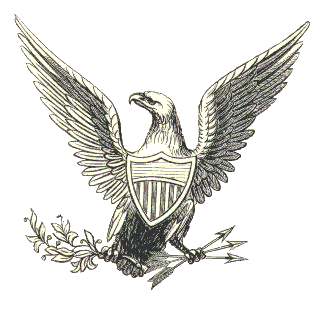Taken from a Marine Corps Instruction Manual

1. Officers and noncommissioned officers execute the sword manual in the same manner, with these following exceptions:
a. Officers grip the scabbard below the brass ring mounting with their left hand. Turn it clockwise 180 degrees. Tilt it forward to form an angle of 45 degrees with the deck. 2. Officers and NCOs draw and return sword, without command, when the commander of their unit does. Unless members of the commander's staff, they execute all other movements of the sword manual on the commander's command to the unit. The commander of the unit and his staff execute all other movements of the sword manual on the commander's separate command to his staff. Some commands to the staff are given before commands to the unit. 3. The sword will be drawn whenever with armed troops or in command of a unit. 4. Carry sword is assumed when: a. Giving commands. 5. Present sword is assumed when: a. Saluting with the sword. 6. While marching with the sword at the carry, the arms should swing naturally. Do not hold the scabbard or sling.
MOVEMENTS OF THE SWORD
1. Draw Sword. On the preparatory command, DRAW, grasp the scabbard with the left hand just below the frog, tilting it forward to form an angle of 45 degrees from the deck. Grasp the grip with the right hand and pull the sword out approximately ten inches from the scabbard. (Note: Officer six inches) the right forearm parallel to the deck and left hand holding the scabbard against the side. On the command of execution, SWORD, draw the sword smartly, raising the right arm to its full extent, directly to the front, blade at an angle of 45 degrees, sword in a straight line with arm, true edge down, releasing the left hand from the scabbard. PAUSE FOR ONE COUNT. Bring the back of the blade against the shoulder seam, blade vertical, knuckle bow to the front, the right arm nearly extended, the thumb and fore- finger embracing the lower part of the grip, thumb on the trouser seam, the fingers joined behind the end of the hilt. This is the position of CARRY SWORD. This is a three count movement. a. Parade Rest. Executed normally from order sword. If executed from carry sword, come to order on the preparatory command of parade. Executed in one count. At the command of execution, REST, move the left foot and arm as executed when armed with the rifle. At the same time, lower the point of the sword to the deck. On the command of attention, assume the position of attention, raising the point three inches above the deck, at the position of order sword. 8. Return Sword. The command is RETURN, SWORD and may be executed from order sword or carry sword. On the preparatory command, RETURN, raise the right hand to a position six inches in front of, and on line with, your neck. Keep the right thumb on the left side of the grip, wrist straight, elbow held in against the body. The knuckle bow to the left, blade inclined forward at a 30 degree angle. At the same time, with the left hand, grasp the scabbard. Fingers are joined and wrapped around the scabbard, thumbs wrapped around the inboard portion, tilting it for- ward at a 45 degree angle from the deck. (Note: Officers grasp the scabbard with the left hand just above the upper brass ring mounting, and tilt it forward, then turn it clockwise 180 degrees). Lower the sword point to a position just above the throat of the scabbard. Look down at the opening and guide the point into the throat until the right forearm is parallel to the deck; or until the hilt is ten inches from the scabbard, (officers six inches) and raise the head to the front. On the command of execution, SWORD, push smartly down and release the grip of the sword with the right hand, so it will slide all the way into the scabbard. In the same motion, return the right hand to the right side. Release the scabbard with the left hand and return it to the left side, assuming the position of attention.
Artillery Modifications to Proper Handling of the Sword
1. The scabbard is hooked with the straps to the outside.
Sources for These Changes
My notes from an Officer's School at an Olustee Special Event. As the only Artillery Officer present I (Lt. Roy Seavey)
received special one on one instructions from Col. Don Bowman. This heavy, double-edged short sword, modeled after the Roman gladius, was carried by artillery troops during the Civil War. It has a leaf-shaped blade, brass hilt and crossguards, includes a leather scabbard with brass chape and fittings, and is 25 inches in length. This page last updated: March 24, 2003
b. NCOs grip the scabbard just below the frog with their left hand. Tilt it forward to form a 45 degree angle with the deck.
c. Officers withdraw the sword six inches from the scabbard when drawing sword.
d. NCOs withdraw the sword ten inches from the scabbard when drawing sword.
b. Changing position in formation at quick time.
c. Addressing or being addressed by a senior.
d. When the preparatory command for quick time has been given and while marching at quick time.
e. Any manual of arms movement has been ordered, except parade rest, at ease, rest, present arms, order arms, or eyes right (left). When in formation with personnel to your front at normal distance or less (organizational staffs excluded), remain at carry sword except during rest or at ease.
b. The unit is presented to the colors or to persons, or when the national anthem, to the color, retreat, or Hail to the Chief is played.
c. Executing eyes right (left) while marching past a reviewing officer or stand. In the interior of a formation, remain at the carry.
7. While marching at double time, hold the sword diagonally across the chest with the sharp edge toward the front. Hold the scabbard with the left hand just below the frog.
8. When calling roll, reading documents, or publishing orders to a formation, slip the fingers of the left hand between the sword grip and knuckle bow. For officers, between the grip and the sword knot. Allow the sword to hang, grip to the front across the knuckles. Keep the left elbow against the side. Hold the document with both hands.
9. When not in formation, keep the sword in the scabbard. Salute by executing the hand salute.
2. Present Sword From Order or Carry Sword. The command is PRESENT, SWORD (ARMS). Executed only when halted at order or carry sword, in two counts. On the preparatory command, PRESENT, raise the right hand to the level of and six inches in front of your neck. Keep the thumb on the left side of the grip, wrist straight, elbow against the body, the knuckle bow to the left, blade inclined forward at a 30 degree angle. On the command of execution, SWORD or ARMS, whip the point down smartly to a position three inches above the deck and slightly to the right of the right foot. Straighten the right arm. The thumb remains on the left side of the grip, knuckle bow against the trouser seam. The blade is inclined down and forward with the true edge to the left.
3. Order Sword From Present Sword. The command is ORDER, SWORD (ARMS). Executed in one count. On the command of execution, SWORD or ARMS, turn the true edge down. In this position, the right arm hangs naturally, thumb on the trouser seam. The blade inclined down and forward, point, three inches above the deck.
4. Sword Salute From Order or Carry Sword. When it becomes necessary to salute, execute present sword. After your salute has been returned, resume order or carry sword.
5. Eyes Right (Left) From Order or Carry Sword. The command is EYES, RIGHT (LEFT). Executed only when halted at order sword or marching at carry sword. Executed in two counts. While marching, both the preparatory command and the command of execution will be given as the right foot strikes the deck. On the preparatory command EYES, execute the first count of present sword. On the command of execution, RIGHT (left), execute the second count of present sword, at the same time, turn the head and eyes 45 degrees to the right (left). If in the right (left) file, keep the head and eyes to the front.
6. Order or Carry Sword From Eyes Right (Left). When executed from the halt, follow the reviewing officer with the head and eyes until they are to the front. When the movement is terminated, turn the true edge down, executing order sword. When executed on the march, the command is READY, FRONT. Both the preparatory command and the command of execution will be given as the left foot strikes the deck. On the preparatory command, READY, turn the true edge down. On the command of execution, front, smartly turn the head and eyes to the front, at the same time, execute carry sword from order sword.
7. Rests with the Sword
b. At Ease and Rest. Come to order sword, if not already at that position, then execute parade rest as described above. Then you may relax, move about, and when commanded REST, you may talk in a conversational voice. On the preparatory command (Squad, Platoon, or Company), resume the position of parade rest. On the command of ATTENTION, assume the position of attention, at order sword.
Note: The Artillery Officer's Sword is curved, therefore it is referred to as a Sabre.
2. Present Arms: At the command ARMS or Sabre, carry the sabre to the front, arm half extended, thumb to and six inches from the neck, blade perpendicular, edge to the left, thumb extended on the side of the grip, little finger by the side of the others. Do NOT lower until next command.
3. Parade Rest: At the command REST, carry the right foot six inches to the rear, the left knee slightly bent,
the body upright on the right leg, the back of the sabre resting in the hollow of the right arm, the hands
being crossed in front, the left hand over the right. When the sabre is not drawn, the cannoneer, at the
command Parade REST assumes the same position as with sabre drawn, except that instead of crossing the
hands in front, he folds the arms over the chest, with the left arm over the right.
4. In Place Rest: Hands crossed in front, left over right, sabre tip on left foot, right foot six inches back,
posture not as rigid.
5. Order Arms: The sabre is down to the front and right.
6. Shoulder ARMS or Carry SABRE: At the command SABRE, carry the back of the blade against the hollow of
the right shoulder, the wrist resting against the hip, the little finger on the outside of the grip.
Instructions for Field Artillery, approved by Sec. of War John B. Floyd, March 6, 1860, Manual of the
Sabre on Page 84, Para. 19.
Poinsett's Tactics (1841 Cavalry Tactics)
Field Artillery Tactics 1864, under School of the Piece, Manual of the Sabre- Pg. 56, 57

For more detailed information about using a sword, please click:
HERE!
